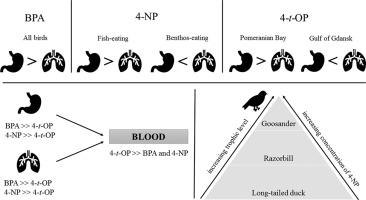Science of the Total Environment ( IF 9.8 ) Pub Date : 2020-09-21 , DOI: 10.1016/j.scitotenv.2020.142435 Karina Bodziach , Marta Staniszewska , Lucyna Falkowska , Iga Nehring , Agnieszka Ożarowska , Grzegorz Zaniewicz , Włodzimierz Meissner

|
Aquatic birds found at the top of the trophic chain are exposed to xenobiotics present both in food and inhaled air. The aim of this study was to indicate and assess the routes and levels of exposure of aquatic birds to bisphenol A (BPA), 4-tert-octylphenol (4-t-OP) and 4-nonylphenol (4-NP). The birds constituting the study material (Clangula hyemalis, Alca torda, Mergus merganser) originated from by-catches (winter 2014-2016) in the Southern Baltic. The studies show that the exposure of birds to phenol derivatives is determined by the specifics of a compound, the habitat area, trophic level and food consumed. BPA was characterized by the highest intestinal concentrations in all birds (6.6–1176.2 ng.g-1 dw). Higher concentrations of 4-t-OP were determined in the lungs of birds from the eastern part of the Southern Baltic (9.1–135.7 ng.g-1 dw) and in the intestines of birds from the western part (<0.5–191.4 ng.g-1 dw). In the case of 4-NP, higher concentrations were found in the intestines of carnivorous species (64.9–524.5 ng.g-1 dw), and the lungs of benthos-eating species (39.4–399.7 ng.g-1 dw). The intestines that were most burdened with 4-NP were those of birds from the highest trophic level. Correlations between the concentrations of phenol derivatives in the blood and the intestines and lungs indicated that birds are exposed to the penetration of phenol derivatives through the digestive and respiratory tracts. BPA and 4-NP were characterized by the highest concentrations in the intestines and lungs, whereas 4-t-OP in blood (3.2–39.2 ng.cm-3), which may indicate the largest endocrine potential of this compound in birds. Significant differences in phenol derivatives concentrations in the intestines and lungs of birds from the western and eastern part of the Southern Baltic, shows that these tissues can be useful for assessing the contamination of the environment with EDCs.
中文翻译:

水禽的胃肠道和呼吸道接触内分泌干扰性酚类化合物
在营养链顶部发现的水生鸟类暴露于食物和吸入空气中均存在的异种生物。这项研究的目的是指出和评估水生禽类接触双酚A(BPA),4-叔辛基苯酚(4- t - OP )和4-壬基苯酚(4-NP)的途径和水平。构成研究材料的鸟类(Clangula hyemalis,Alca torda,Mergus merganser)起源于波罗的海南部的副渔获物(2014-2016年冬季)。研究表明,鸟类对苯酚衍生物的暴露取决于化合物的具体特征,栖息地面积,营养水平和食用食物。BPA的特点是所有鸟类的肠道最高浓度(6.6–1176.2 ng.g-1 dw)。在波罗的海南部东部地区的鸟类的肺部(9.1–135.7 ng.g -1 dw)和西部地区鸟类的肠道(<0.5–191.4 ng)中确定了较高的4- t - OP浓度.g -1 dw)。在4-NP的情况下,在肉食性物种的肠道(64.9–524.5 ng.g -1 dw)和以底栖动物为食的物种(39.4–399.7 ng.g -1)的肺中发现更高的浓度。dw)。4-NP负担最重的肠道是营养水平最高的鸟类。血液与肠和肺中苯酚衍生物的浓度之间的相关性表明,鸟类暴露于苯酚衍生物通过消化道和呼吸道的渗透。BPA和4-NP的特征是在肠道和肺中的浓度最高,而血液中的4- t -OP(3.2–39.2 ng.cm -3),这可能表明该化合物在鸟类中具有最大的内分泌潜能。在波罗的海南部和东部的鸟类的肠道和肺中,酚衍生物的浓度存在显着差异,表明这些组织可用于评估EDC对环境的污染。


























 京公网安备 11010802027423号
京公网安备 11010802027423号